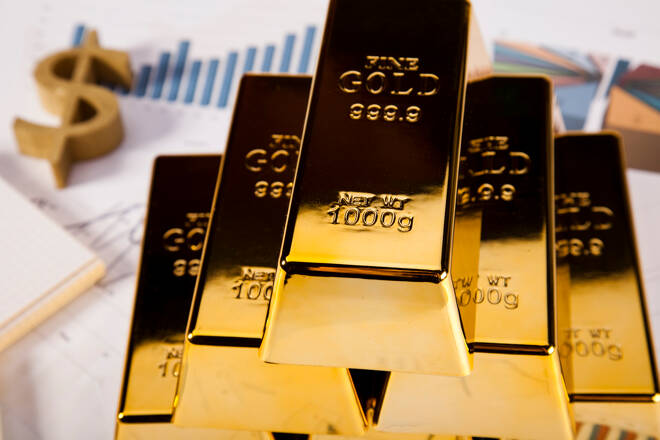Heavy Metal: How Precious & Non-Ferrous Metals Can Predict The Future World Economy
Published: Apr 10, 2022, 15:59 GMT+00:00
The term heavy refers to weight. In the case of this headline, the weight of these metals could not be more significant when it comes to their influence on the future global economy.
The growth in precious metals as a safe haven and base metals as a primary industrial driver is considered a leading indicator of what might be ahead. Copper, gold, palladium, and more all reflect the situation looming over the economy and the impact on investors’ moods.
We examine the potentially dire situation, and how precious and non-ferrous metals can predict the future world economy.
The Gold Standard And Industrial Effect Of Metals
Everyone has heard of the gold standard, but few know this refers to a time when fiat currencies from around the world were pegged to the price of gold and it served as the perfect economic unit of account. Unpegging the dollar and other currencies allows inflation to occur, which central bankers use to expand the economy. However, inflation rates have been at the highest since the 1980s in the US, and it has suddenly changed the risk appetite towards metals.
Because of the monetary attributes of gold, traditional investors have always used the precious metal as a hedge against inflation and a safe haven for capital during negative macroeconomics or geopolitical events. Since the 1970s, the price of gold has grown more than 5,000%. The hard money asset fell from the 1980s to the 2000s after the US Federal Reserve sent its printing press into overdrive.
Statistics also show that for every 1% increase in the consumer price index – the key measure of inflation rates in the US – the price of copper climbs by 18% on average. Base metals have a similar scarcity as precious metals and therefore demonstrate similar economic behavior. Palladium and silver prices also draw significant investor interest during usually challenging economic times. Each also offers utility to the tech industry and green energy sectors.
The Fed’s Broken Monetary Policy And Inflation Rates
The founders of the current monetary system advocated that the money supply should expand at pace with the growth rate of the gross domestic product. The concept would allow the money supply to support expanding demand while maintaining an acceptable inflation rate. The problem with this situation lies in the numbers themselves.
The US money supply has grown by 800%, while real GDP growth has only been a mere 55%. Before the COVID pandemic, monetary supply growth was nearly 500%, while GDP growth was only 45%. The sudden further expansion in supply has prompted the consumer inflation rate to reach 8%, according to official data – a high rate even for developing countries.
Traders watching the situation in copper should conclude that if copper is falling in price, it is terrible for the economy as the market reflects a scary situation occurring within the industrial sector. Such a situation would indicate that industrial production was being cut, mining operations were being reduced, and more, which all would contribute to a price drop in the sector.
Meanwhile, falling gold and silver prices or a sideways trend is more indicative of a stronger economy as it suggests investors are willing to take on more risk. With more risk appetite, there is a significant withdrawal of capital from protective assets and investment toward businesses, stocks, IPOs, cryptocurrencies, and other risk-on assets.
But what exactly are we seeing today based on the ongoing trend? Over the last 14 years alone, precious and non-ferrous base metals have all yielded 4x to 10x in growth, regardless of the situation brewing in the global economy. Due to the scarcity of these essential commodities, as the money supply increases and inflation spirals out of control, the value of precious and base metals respond with substantial growth.
Build An Inflation-Resistant Portfolio With PrimeXBT
It is also no surprise that new technologies like Bitcoin have appeared over the last 13 years with the monetary supply so out of control. The US and world economy is in trouble and has been for well over 20 years. This losing battle is ready to come to a climax, but when? It is important to be prepared for anything and have access to a wide range of inflation-resistant assets.
With the award-winning margin trading platform, PrimeXBT, traders can access not only Bitcoin but an assortment of metals that can help protect against inflation, along with a way to keep profits coming during tough economic times. The reliable and ultra-fast trading platform also offers exposure to fiat currencies, stock indices, and other vital commodities, as well as a massive list of cryptocurrencies – so there are still plenty of options to keep any occasional risk appetite satisfied.
PrimeXBT also provides a way to leverage the skills and talents of more experienced traders who know how to navigate the dangerous times ahead. With the Covesting copy trading module, followers can find a ranked leaderboard filled with traders who have maintained a high ROI even amidst all the market turmoil and volatility related to inflation and the Fed’s sudden attempt at tightening.
With no end in sight to inflation, protecting capital becomes the primary objective. Profits are less common but still there for those that know where to look. Look no further than the powerful margin trading accounts provided by PrimeXBT.
About the Author
Promotional Contentcontributor
FXEmpire provides its readers and partners with this section in order to share the value proposition and products that may be relevant for FXEmpire
Advertisement
